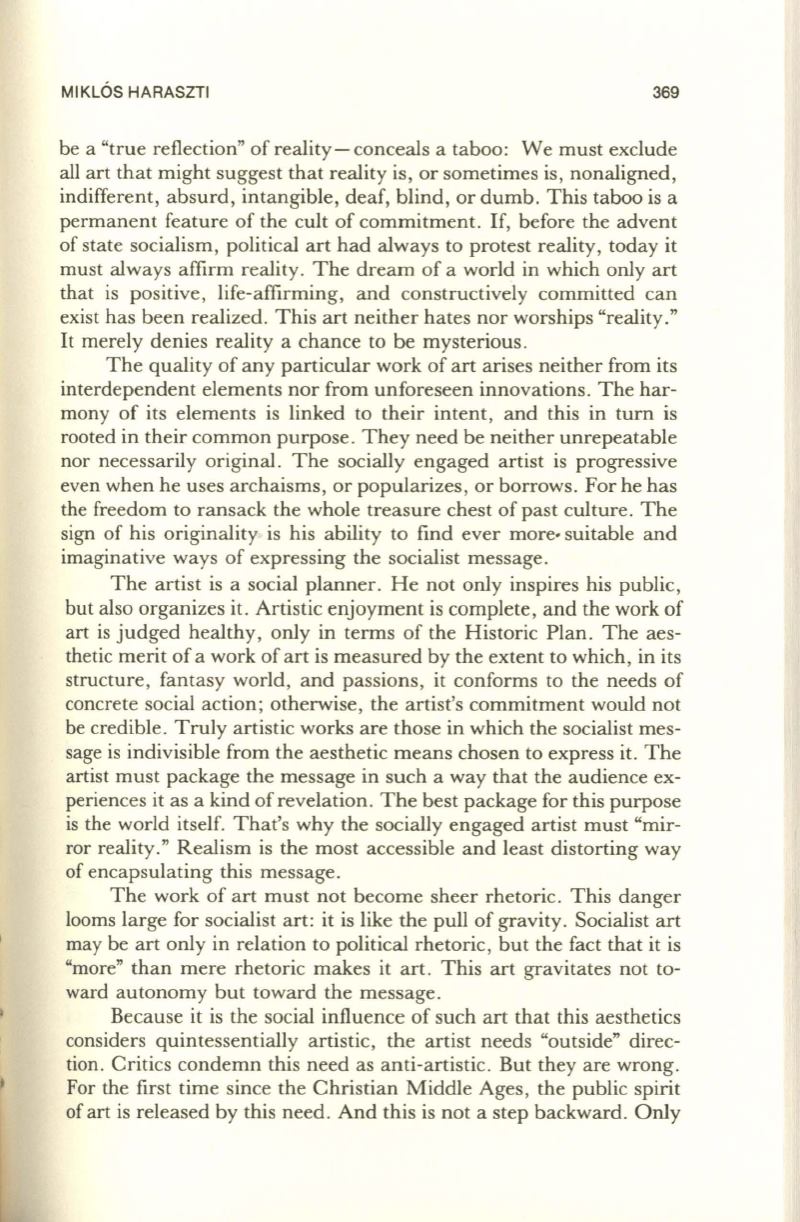
MIKL6s HARASZTI
369
be a "true reflection" of reality- conceals a taboo : We must exclude
all art that might suggest that reality is, or sometimes is, nonaligned,
indifferent, absurd, intangible, deaf, blind, or dumb. This taboo is a
permanent feature of the cult of commitment. If, before the advent
of state socialism, political art had always to protest reality, today it
must always affirm reality . The dream of a world in which only art
that is positive, life-affirming, and constructively committed can
exist has been realized . This art neither hates nor worships "reality."
It merely denies reality a chance to be mysterious .
The quality of any particular work of art arises neither from its
interdependent elements nor from unforeseen innovations . The har–
mony of its elements is linked to their intent, and this in turn is
rooted in their common purpose . They need be neither unrepeatable
nor necessarily original. The socially engaged artist is progressive
even when he uses archaisms, or popularizes, or borrows. For he has
the freedom to ransack the whole treasure chest of past culture. The
sign of his originality is his ability to find ever more- suitable and
imaginative ways of expressing the socialist message.
The artist is a social planner. He not only inspires his public,
but also organizes it. Artistic enjoyment is complete, and the work of
art is judged healthy, only in terms of the Historic Plan. The aes–
thetic merit of a work of art is measured by the extent to which, in its
structure , fantasy world, and passions , it conforms to the needs of
concrete social action ; otherwise, the artist's commitment would not
be credible . Truly artistic works are those in which the socialist mes–
sage is indivisible from the aesthetic means chosen to express it. The
artist must package the message in such a way that the audience ex–
periences it as a kind of revelation . The best package for this purpose
is the world itself. That's why the socially engaged artist must "mir–
ror reality. " Realism is the most accessible and least distorting way
of encapsulating this message .
The work of art must not become sheer rhetoric . This danger
looms large for socialist art: it is like the pull of gravity. Socialist art
may be art only in relation to political rhetoric, but the fact that it is
"more" than mere rhetoric makes it art. This art gravitates not to–
ward autonomy but toward the message.
Because it is the social influence of such art that this aesthetics
considers quintessentially artistic, the artist needs "outside" direc–
tion. Critics condemn this need as anti-artistic. But they are wrong.
For the first time since the Christian Middle Ages, the public spirit
of art is released by this need. And this is not a step backward. Only


